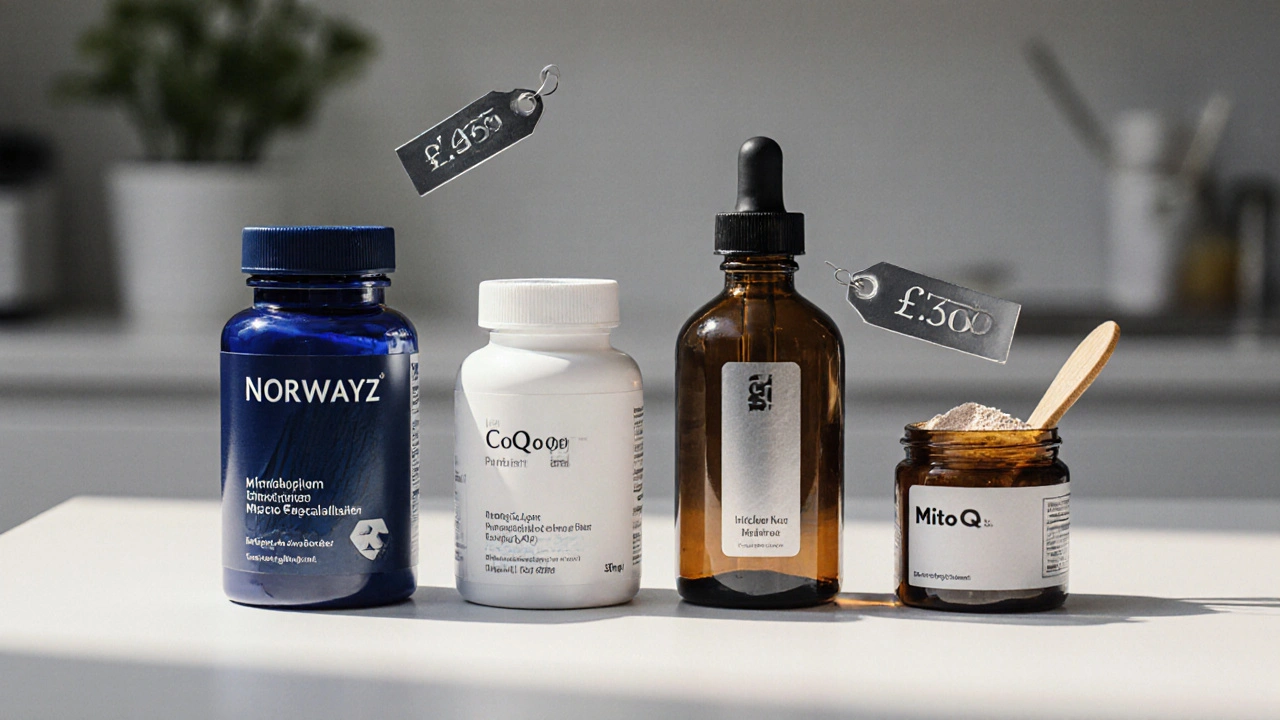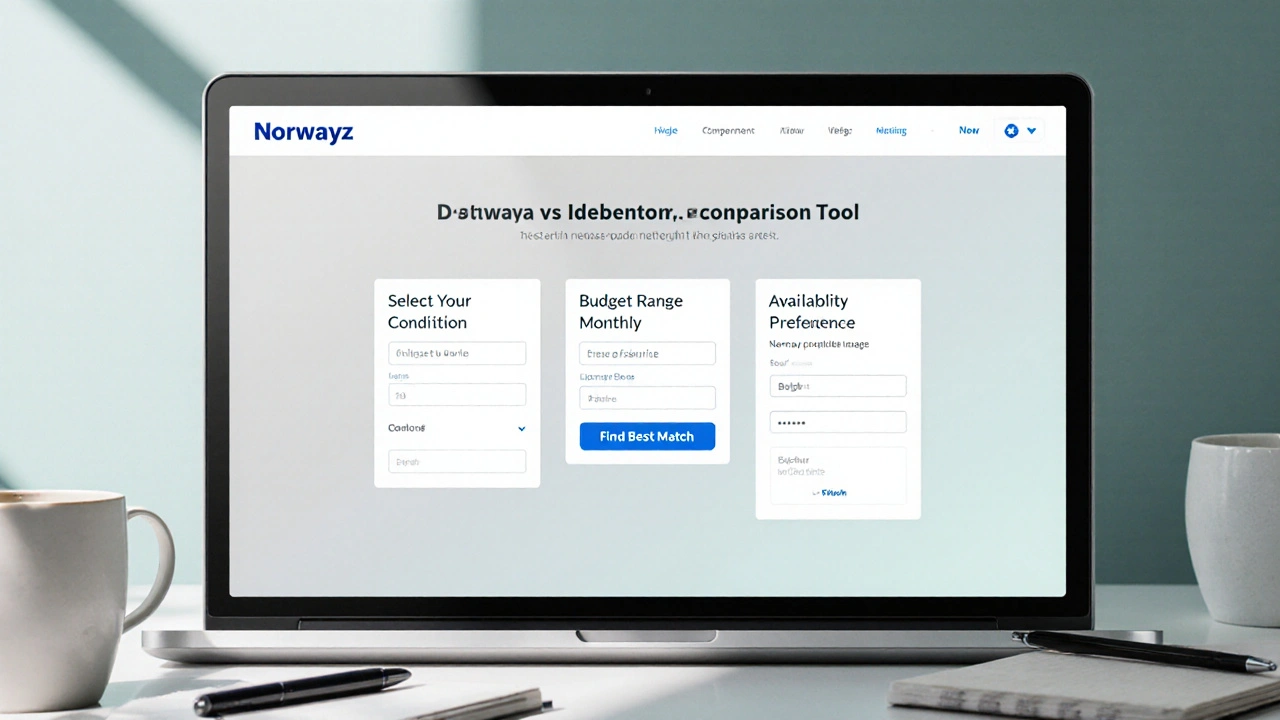Norwayz vs Alternatives: Idebenone Comparison Tool
Recommended Option:
Why This Option?
Key Takeaways
- Norwayz contains idebenone, a synthetic analog of CoQ10, approved for certain mitochondrial disorders.
- Raxone (another idebenone brand) is the most direct competitor; both share similar dosing but differ in price and regional availability.
- CoQ10, MitoQ, and other antioxidants offer broader antioxidant support but lack the specific clinical data that idebenone has for LHON and Friedreich’s ataxia.
- Cost, regulatory status, and the condition you’re treating are the three biggest decision factors.
- Always check dosage recommendations and potential drug interactions before starting any supplement.
If you’ve landed on this page, you’re probably weighing whether Norwayz is the right choice for your health goal or if another product might give you better value or results. Below you’ll find a clear rundown of what Norwayz actually is, how it stacks up against the most common alternatives, and practical advice on picking the best fit for your situation.
What is Norwayz?
Norwayz is a branded oral supplement that delivers idebenone, a synthetic antioxidant derived from coenzyme Q10. It was originally launched in Europe under the name Raxone and later re‑branded for certain markets. The product is marketed for patients with mitochondrial dysfunctions such as Leber’s hereditary optic neuropathy (LHON) and Friedreich’s ataxia (FA), where clinical trials have shown modest visual and neurological benefits.
Typical dosing ranges from 30mg twice daily for mild cases up to 90mg three times daily for severe mitochondrial disease. The formulation uses micro‑encapsulation to improve gut absorption, a point the manufacturer highlights as a key differentiator.
How Idebenone Works
Idebenone (chemical name: 2‑hydroxy‑5‑dodecyl‑3‑(1‑hydroxy‑1‑methylethyl)‑1,4‑benzoquinone) mimics the electron‑carrier function of CoQ10 but boasts a shorter side chain, which lets it cross the blood‑brain barrier more efficiently. In the mitochondria, it shuttles electrons from complex I to complex III, bypassing damaged sections of the respiratory chain. This reduces oxidative stress and stabilises ATP production.
Clinical evidence largely comes from two sources:
- Randomised controlled trials in LHON patients showing a 30‑45% improvement in visual acuity over 12‑month treatment periods.
- Open‑label studies in Friedreich’s ataxia demonstrating modest gains in cardiac function and gait speed after 24‑month exposure.
Because it targets a specific pathway, idebenone’s effect is more pronounced in diseases where complex I dysfunction is the primary driver. For broader oxidative‑stress conditions, general antioxidants may be more appropriate.

Top Alternatives to Norwayz
Below are the most widely available products that patients compare with Norwayz. Each entry includes a brief definition with microdata for the first mention.
Raxone is the original commercial name of idebenone sold primarily in Germany, Italy, and a handful of other EU countries. It carries the same active ingredient (idebenone) but is priced slightly higher due to brand‑recognition premiums.
CoQ10 (ubiquinone) is the natural form of the co‑enzyme that idebenone mimics. Over‑the‑counter formulations range from 30mg to 300mg per capsule and are widely used for general mitochondrial support, heart health, and age‑related fatigue.
MitoQ is a mitochondria‑targeted antioxidant that links a ubiquinone moiety to a lipophilic triphenylphosphonium cation, allowing it to accumulate inside mitochondria at high concentrations. It’s positioned as a premium anti‑age and neuro‑protective supplement.
Idebenone Generic refers to unbranded idebenone powders or capsules manufactured in the United States and Asia. These products typically lack the micro‑encapsulation technology of Norwayz but can be considerably cheaper per milligram.
Other broader antioxidants such as alpha‑lipoic acid, resveratrol, and NAD+ precursors (nicotinamide riboside) sometimes appear in “idebenone alternatives” lists, but they act on different pathways and lack head‑to‑head clinical data.
Side‑by‑Side Comparison
| Brand | Active Ingredient | Typical Dose | Approved Indication | Key Clinical Evidence | Approx. Monthly Cost (USD) | Availability |
|---|---|---|---|---|---|---|
| Norwayz | Idebenone (micro‑encapsulated) | 30‑90mg 2‑3×/day | LHON, Friedreich’s ataxia, other mitochondrial disorders | PhaseIII LHON trial (45% visual gain), FA open‑label study | $120‑$180 | EU, select US pharmacies (prescription) |
| Raxone | Idebenone (standard) | 30‑90mg 2‑3×/day | LHON (EU approved) | Same as Norwayz; European guideline endorsement | $150‑$210 | Germany, Italy, Spain, UK (prescription) |
| CoQ10 (OTC) | Ubiquinone | 100‑300mg 1‑2×/day | General mitochondrial support, heart health | Observational studies; no disease‑specific RCTs | $30‑$70 | Global (OTC) |
| MitoQ | Ubiquinone‑TPP conjugate | 10‑20mg 1×/day | Age‑related oxidative stress, neuro‑protection | Small RCTs show improved endothelial function | $80‑$120 | Global (OTC) |
| Idebenone Generic | Idebenone (non‑encapsulated) | 30‑90mg 2‑3×/day | Off‑label mitochondrial support | Same trials as Norwayz but no brand‑specific data | $50‑$90 | Online retailers, compounding pharmacies |
How to Choose the Right Option
When you line up the numbers, the decision usually boils down to three questions:
- Do you need disease‑specific evidence? If you’re treating LHON or Friedreich’s ataxia, the idebenone‑based products (Norwayz, Raxone, generic idebenone) are the only ones with peer‑reviewed data showing benefit.
- What’s your budget? Generic idebenone or a high‑dose CoQ10 can save you $70‑$120 per month compared with Norwayz, but you may trade off the micro‑encapsulation advantage that improves absorption.
- Where can you get it? Prescription‑only status in many countries means you’ll need a doctor’s approval for Norwayz or Raxone. Over‑the‑counter alternatives like CoQ10 and MitoQ are easier to buy but lack the regulatory backing.
Here’s a quick rule‑of‑thumb matrix:
- If you have a confirmed LHON diagnosis and your insurer covers prescription meds → go with Norwayz or Raxone.
- If you’re looking for general mitochondrial support without a formal diagnosis → CoQ10 or MitoQ are cost‑effective.
- If price is the biggest barrier and you can tolerate a slightly lower bioavailability → consider a reputable generic idebenone source.
Practical Tips for Buying and Using Norwayz
- Prescription check. In the UK, Norwayz is classified as a “specials” product and usually requires a specialist’s endorsement.
- Timing with meals. Take the capsules with a fatty meal (e.g., avocado, nuts) to maximise absorption.
- Monitor labs. Baseline liver function tests are recommended because high‑dose idebenone can mildly elevate transaminases.
- Stay consistent. Benefits often appear after 3‑6months of daily use; stopping early may erase early gains.
- Combine wisely. Avoid simultaneous high‑dose CoQ10 supplementation without consulting a clinician, as overlapping antioxidant pathways can cause unforeseen interactions.

Frequently Asked Questions
Is Norwayz the same as Raxone?
Yes. Both contain the same active ingredient, idebenone, but Norwayz uses a micro‑encapsulation process that may improve gut absorption. The branding differs by market.
Can I take Norwayz together with CoQ10?
It’s generally safe, but since both act on mitochondrial electron transport, high doses can lead to excess antioxidant activity. Talk to a physician before stacking them.
What dosage is recommended for LHON?
Clinical trials used 90mg three times daily for up to 12months. Some clinicians start at 30mg twice daily and titrate up based on tolerance.
Is there any insurance coverage for Norwayz in the UK?
The NHS may fund Norwayz for approved indications like LHON if a specialist submits a prescription. Private insurance varies; check individual policy terms.
How does MitoQ differ from idebenone?
MitoQ is a ubiquinone linked to a lipophilic cation, which drives it straight into mitochondria. Idebenone works by bypassing complexI defects. Their mechanisms overlap but are not interchangeable.








Posts Comments
Frank Reed October 4, 2025 AT 14:56
Hey folks, great rundown of the idebenone options! I think the micro‑encapsulation thing really makes a differecne for absorption. If you can afford Norwayz, it's worth trying, especially for LHON. Just keep an eye on liver tests, and stay consistent.
Bailee Swenson October 4, 2025 AT 16:36
Honestly, Norwayz is overrated 🙄
tony ferreres October 4, 2025 AT 18:33
Reading through the guide feels like stepping onto a philosophy class about mitochondria. The way idebenone bypasses complex I is a clever workaround, echoing the idea that often the shortest path isn't the most obvious. While the data for LHON is decent, we must remember that most users are looking for general energy boost, not just disease‑specific outcomes. So, if you're not clinically diagnosed, a broader antioxidant like CoQ10 might serve you better. The micro‑encapsulation claim is intriguing, yet without head‑to‑head trials we can't be certain of its superiority. Ultimately, the decision rests on personal goals, budget, and medical guidance. Stay curious and keep questioning the hype.
Arjun Premnath October 4, 2025 AT 20:46
I see where you're coming from, but the clinical data on idebenone can't be dismissed. Some patients report visual improvements that generic CoQ10 just doesn't match. If cost is a concern, look for reputable generic sources that still meet quality standards.
Johnny X-Ray October 4, 2025 AT 23:33
Wow, this guide really fires me up! 🌟 The drama of battling mitochondrial disorders feels like an epic quest, and Norwayz is the shining sword that could turn the tide. Yet, the price tag can feel like a dragon guarding the treasure. If you can summon the funds, go for the micro‑encapsulated version and watch the magic happen. Otherwise, the trusty sidekicks CoQ10 or MitoQ still make for solid allies.
Mark Rohde October 5, 2025 AT 03:43
could've used more data 😂
Rajan Desai October 5, 2025 AT 09:16
The cost breakdown is really helpful. Knowing that a generic idebenone can shave off $70‑$120 each month makes budgeting easier. Just remember to verify the source's quality before committing.
S O'Donnell October 5, 2025 AT 16:13
Having perused the comparative matrix, it is incumbent upon the discerning consumer to undertake a meticulous evaluation of the pharmacoeconomic implications inherent to the therapeutic regimen under consideration. The extant literature, albeit robust in its elucidation of idebenone's mechanistic underpinnings, reveals a paucity of longitudinal data with respect to sustained clinical outcomes beyond the twelve‑month horizon, thereby engendering a measure of epistemic uncertainty. Moreover, the micro‑encapsulation technology purportedly augments bioavailability; however, the stochastic variability associated with gastrointestinal absorption may attenuate the hypothesized pharmacokinetic advantage, particularly in patient cohorts with comorbid malabsorption syndromes. It is also noteworthy that the regulatory landscape delineates a bifurcation between prescription‑only formulations and over‑the‑counter analogues, a dichotomy that carries implications for both access and insurance reimbursement paradigms. The fiscal exigency of Norwayz, situated in the $120‑$180 monthly bracket, must be juxtaposed against the more economical generic alternatives whose price points oscillate between $50‑$90, albeit with potential compromises in formulation integrity. In addition, the ancillary requirement for hepatic function monitoring imposes ancillary costs and logistical considerations that merit inclusion in a comprehensive cost‑benefit analysis. While the data corpus substantiates modest visual acuity improvements in LHON populations, extrapolation to broader mitochondrial dysfunctions remains speculative. Consequently, clinicians and patients alike ought to calibrate therapeutic decisions against a matrix of clinical efficacy, safety profile, economic burden, and individual patient preference, thereby fostering an optimally tailored treatment paradigm.
Yamunanagar Hulchul October 6, 2025 AT 01:56
What a spectacularly vivid guide! 🎉 The kaleidoscope of options gleams like a technicolor rainbow, illuminating the path for anyone seeking mitochondrial marvels. From the regal elegance of Norwayz to the humble charm of CoQ10, each choice dances with its own unique flair! Keep the enthusiasm soaring, and may your cells sparkle with boundless energy!!!
Sangeeta Birdi October 6, 2025 AT 14:26
Absolutely love the upbeat tone! 🌈 Remember to listen to your body and consult a healthcare professional before starting any new supplement. Wishing everyone the best on their mitochondrial journey! 😊
Write a comment